
Photo right, l to r: Christina Lyons, asst. professor & chairperson, FIT Graduate Exhibition & Experience Design; Larina Cipolla, designer, Czarnowski; and Brenda Cowan, assoc. professor, Graduate Exhibition Design #B231, SUNY/Fashion Institute of Technology
When the invitation came to speak at the FIT Capstone Event, I was beyond thrilled.
To understand why, let me give you a bit of background, particularly for those of you who don’t know about this program.
FIT’s Master of Arts in Exhibition Design is a full-time, 39-credit program completed in 16 months. Most coursework is studio-based and is combined with projects that are conducted directly with patron museums, design firms, and trade venues. Students learn to plan and build three-dimensional models, apply typographic solutions to brand identity issues, and incorporate graphic, lighting, interactive, and audiovisual elements into small- and large-scale designs. They can apply their skills to an actual exhibition project. Internships at design firms, museums, exhibit marketing firms, and exhibition design and production companies offer networking and career opportunities.
The Master of Arts program culminates in an independent thesis project and capstone event where students demonstrate their design, research, writing, and critical-thinking skills in a final exhibition design and academic paper, presented to program faculty and an international panel of experts. More than 45 industry professionals take part in a day-long adjudication of final student work. Industry leaders including creative directors, CEOs, exhibit developers, audience specialists, writers, researchers, content experts, design educators, recruiters, journalists, events marketers and project managers comprise this group of individuals who travel from throughout the world to review theses and lend their expertise to the graduating class.
I had previously participated as a judge; I so admire the students’ work because it is truly outside the realm of my personal capabilities. Selfishly, the day is an amazing opportunity to network with designers and faculty members, people who work in retail and fashion and museums, who aren’t part of my daily world.
Finally, as a member of EDPA, I support the work our organization does to foster this young talent. Celebrating 10 years, EDPA’s University Affiliation Program supports exhibit design studies at FIT as well as Bemidji State in Minnesota. EDPA provides mentors for the students and often provides opportunities for students to intern at member companies. Both chairs of this committee within EDPA, Dana Esposito and Justin Dworak were speakers at Capstone.
What was truly special this year—and why I was so thrilled to be the keynote speaker—is that the entire 2016 class was women. Dana spoke about her experience as the only female designer in a group of “chain smoking old guys,” and since I am older than Dana, I can honestly say that was an improvement over what I encountered when I was, to blatantly steal her phrase, “the last cookie in the jar.”
When I spoke to the class, I wanted to focus on their new path, not give a history lesson. And what I consider very important was for designers to be brought in, not at the tactical level, as so often happens, but as part of—if not the lead on—the strategy team. Design isn’t about ooh and ahh—it’s about process, or in the words of Milton Glaser, “Design is the process of going from an existing condition to a preferred one.”
Their job in the coming years will be to translate the goals and brand messages of their clients into visual and experiential messages, not to ask their clients what they “want.” In taking the lead, they will embrace “creative bravery” as defined by the 2013 Cannes Lions (Work that takes chances in pursuit of excellence and changes the status quo. The investment in creative brilliance and bravery is a safe business decision). They will hone their leadership skills, and manage the risk averse on their teams, both internal and external. They will learn to communicate effectively and patiently, to not be pelted with buzz words that have no actual meaning, and to learn to keep the business case for the work they are doing front and center.
But more than anything, as they move forward in their careers, they need to stay authentic, to stay relevant, and stay real. And to that end, I closed with a favorite passage from Margery Williams’ The Velveteen Rabbit.
“Real isn’t how you are made,’ said the Skin Horse. ‘It’s a thing that happens to you. When a child loves you for a long, long time, not just to play with, but REALLY loves you, then you become Real.’ ‘Does it hurt?’ asked the Rabbit. ‘Sometimes,’ said the Skin Horse, for he was always truthful. ‘When you are Real you don’t mind being hurt.’ ‘Does it happen all at once, like being wound up,’ he asked, ‘or bit by bit?’ ‘It doesn’t happen all at once,’ said the Skin Horse. ‘You become. It takes a long time. That’s why it doesn’t happen often to people who break easily, or have sharp edges, or who have to be carefully kept. Generally, by the time you are Real, most of your hair has been loved off, and your eyes drop out and you get loose in the joints and very shabby. But these things don’t matter at all, because once you are Real you can’t be ugly, except to people who don’t understand.”
The infusion of new insights, new vision, and new talent that the Capstone event represents is an indication that the exhibit and event industry is alive and well.





























